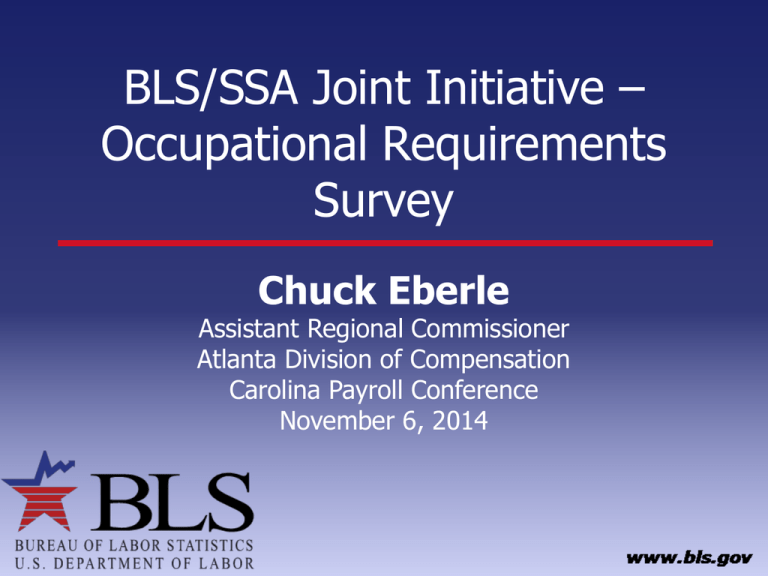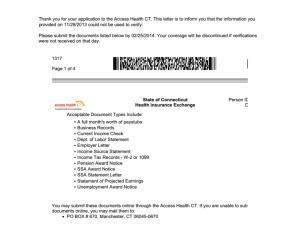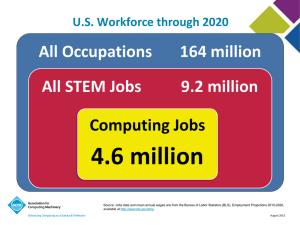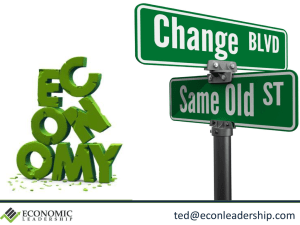BLS/SSA Joint Initiative * Occupational Requirements Survey
advertisement

BLS/SSA Joint Initiative – Occupational Requirements Survey Chuck Eberle Assistant Regional Commissioner Atlanta Division of Compensation Carolina Payroll Conference November 6, 2014 Objectives of the Presentation Who is impacted by the current process? SSA’s Disability Process SSA’s 5 step sequential evaluation in determining claimants qualification for disability benefits. How did BLS get Involved? Why is BLS considered the appropriate agency to collect this information? What has BLS done so far? What are BLS’ future plans? What are the expected outcomes? 2 Who is impacted by the current process? In an obscure corner of the federal bureaucracy, there is an office that is 990,399 cases behind. That is Washington’s backlog of backlogs — a queue of waiting Americans larger than the populations of six different states. It is bigger even than the infamous backups at Veterans Affairs, where 526,000 people are waiting in line, and the patent office, where 606,000 applications are pending. All of these people are waiting on a single office at the Social Security Administration. Source: WashingtonPost.com Written by David A. Fahrenthold Published on October 18, 2014 3 Some Statistics: Current Population of the United States: 319,165,869 Current number of employees working in US: 157,627,118 Percentage of US/citizens working: 49.39% Current Unemployment Rate: 5.9% Number of people waiting for their disability cases to be heard by SSA: 990,399 Percentage of disability cases to working Americans: .006 or 6 tenths of 1% of workers. 4 SSA’S DISABILITY PROCESS SSA’S 5 STEP SEQUENTIAL EVALUATION Sequential Evaluation Process Adults 1. SGA? NO − Go to 2. 2. Severe? YES − Go to 3. 3. Meets/equals listing? YES − Disabled YES − Not disabled NO − Not disabled NO −−−RFC Assessment ~~~~~~~~~~~~~~~~~~~~~~~~~~~~~~~~~~~~~~~~~~~~~~~ 4. PRW? NO − Go to 5. YES - Not disabled 5. Other work? YES − Not disabled NO − Disabled either way: 20 CFR 04.1520/416.920 6 Step 1: Is the individual working above SGA level? At the first step, we consider an individual’s work activity, if any. SGA stands for Substantial Gainful Activity and the amount changes each year. For 2014 it is $1070/month for the non-blind and $1800 for the blind. If an individual is working and his or her earnings average more than the SGA limit a month, then he or she is found not disabled. If an individual is not working or his or her earnings are less than SGA, the adjudicator goes to step two. 7 Step 2: Is the individual’s physical and/or mental condition severe? At the second step, we consider the medical severity of an individual’s impairment(s). An individual must have a medically determinable physical or mental impairment (or a combination of impairments) that is severe and meets the duration requirement. To be severe an impairment or impairments must interfere with basic work-related activities. To meet the duration requirement the impairment(s) must be expected to last twelve months or to result in death If the impairment(s) are not severe or do not meet the duration requirement, the individual is found not disabled. If the impairment(s) are severe and meet the duration requirement, the adjudicator goes to question three. 8 Step 3: Does the individual’s medical condition meet or equal the severity of a Listing? At the third step, we also consider the medical severity of an individual’s impairment(s). SSA maintains a listing of medical criteria that are considered to be so severe that an individual is found to be disabled if his or her medically determinable physical or mental impairment(s) matches them. An individual’s impairment(s) can be found to meet the listed criteria exactly or to be of equal severity. If an individual has an impairment that meets or equals one of the listings and meets the duration requirement, he or she is found to be disabled. If an individual does not have an impairment that meets or equals one of the listings or the duration requirement is not met, the adjudicator goes to Step 4. However, before going from step three to step four, the individual’s residual functional capacity (RFC) is assessed. This RFC assessment is then used at both step four and step five. 9 Residual Functional Capacity (RFC) For the physical RFC (PRFC) an individual’s medical condition is evaluated in terms of the physical demands of work used in the Dictionary of Occupational Titles (DOT) and Selected Characteristics of Occupations (SCO). Both last revised in 1991. Mental RFC (MRFC) is evaluated in terms of the mental demands of work set out in the Code of Federal Regulations (CFR). The sole purpose of assessing RFC is to determine an individual’s ability to work at steps 4 and 5. 10 Step 4: Can the individual do any of his/her Past Relevant Work? At step 4 a function-by-function comparison of the individual’s RFC and past relevant work (PRW) is completed. If an individual retains the physical and mental capacity to perform any PRW, he/she Is found not disabled. If no PRW can be done, or the individual has no relevant work, the adjudicator goes to step five. 11 STEP 4 HAS TWO PARTS Does the individual retain the capacity to perform PRW as he or she actually performed it? Does the individual retain the capacity to perform PRW as generally performed in the national economy? 12 Step 5 the “burden of proof” At step 5 the “burden of proof” shifts to SSA to show that work, other than what the individual performed in the past, exists in significant numbers in the national economy that he or she can make an adjustment to, considering the limiting effects of the individual's impairment, age, education, and work experience. 13 THE DISABILTY PROCESS Currently, we base medical-vocational decisions at steps four and five on the occupational information found in the Department of Labor’s (DOL) Dictionary of Occupational Titles (DOT) and its companion volume, the Selected Characteristics of Occupations (SCO). Although DOL did not design the DOT for SSA’s use, they adapted their disability program to it by incorporating many of its concepts and definitions into their regulations and policies. DOL stopped updating the DOT in 1991 and replaced it with the Occupational Information Network (O*NET), which was designed for training and career exploration. O*NET’s definitions of some occupational measures do not conform to requirements in SSA’s regulations, and they are not able to use O*NET in its current format in their disability adjudication process. 14 THE DISABILTY PROCESS – cont. More than half of the decisions SSA makes at the initial level, and over 80 percent at the hearing level, are medical-vocational decisions that require current occupational information about work that exists in the national economy. Thus, we face the critical challenge to develop or adapt an OIS that can replace the DOT. 15 HOW DID BLS GET INVOLVED? 16 Advisory Panel Established In August of 2008, SSA assembled a project team to develop the Occupational Information System (OIS), and in December 2008, SSA established the Occupational Information Development Advisory Panel (the Panel), in accordance with the Federal Advisory Committee Act. During the first three years of OIS development, our project staff performed research to identify our specific disability program needs for an OIS. The charter for the Panel expired on July 6, 2012. 17 Although the panel recommended that SSA develop a new OIS tailored specifically for their disability program needs, congress expressed concern over the projected cost of the project and suggested that SSA work with DOL to develop the updated occupational information needed. 18 SSA & BLS Interagency Agreement In July 2012, we signed an interagency agreement with the Bureau of Labor Statistics (BLS) to test occupational data collection methods that could lead to the development of a new Occupational Information System (OIS). The new OIS will replace the outdated Dictionary of Occupational Titles (DOT) in our disability determination process. In fiscal year 2013, BLS began testing the feasibility of using the National Compensation Survey (NCS) platform as a means to gather the occupational data we need for our OIS. WHY IS BLS CONSIDERED THE APPROPRIATE AGENCY TO COLLECT THIS INFORMATION? 20 National Compensation Surveys Employment Cost Index collects: 1) Occupations are selected using Probability Sampling of Occupations (PSO) 2) Job descriptions to code each position using the Standard Occupational Classification (SOC) handbook. 3) All occupations are leveled using a point-factor method to determine its work level based on related duties and responsibilities. 4) Four factors—knowledge, job controls and complexity, contacts (nature and purpose), and physical environment. 21 ORS Design Goals vs. NCS Design Goals ORS Design Goals NCS Design Goals Specific Occs Occupational Groups SSA Fav. List ORS! Worker Levels Industry Detail Large Area Estimation NCS! Lots of Estimates 22 Specifically, BLS will collect: An indicator of "time to proficiency," defined as the amount of time required by the typical worker to learn the techniques, acquire the information, and develop the facility needed for average job performance, comparable to the Specific Vocational Preparation (SVP) used in the DOT. Physical Demand (PD) characteristics/factors of occupations measured in such a way to support SSA disability program needs, comparable to measures in Appendix C Physical Demands of the SCO. Environmental conditions that replicate as closely as possible those listed in Appendix D Environmental Conditions of the SCO, or specific revisions or additions to these factors as agreed upon by SSA and BLS. 23 Comparison of NCS and ORS NCS ORS Sample Size 11,400 ~ 30,000 Geographic Detail National and 15 largest metropolitan areas National Occupational Detail Major groups Detailed SOC – 8-digit if possible Estimates Index, Level, Percentiles Percent of workers with an ORS characteristic, mean, percentiles Focus Cost of Labor Characteristics of work Scope Occupations within establishments Occupations within establishments Data provider HR department, managers HR department, managers 24 WHAT HAS BLS DONE SO FAR? 25 FY 2013 -- TESTING In FY 2013, BLS & the OIS team conducted a three-phase field test to evaluate survey design options; begin developing collection protocols and aids; collect data to test, refine the protocols and aids; and assess initial feasibility of using the NCS as a platform to collect the information SSA needs for the OIS. 26 FY 2013 -- Phase 1 Phase 1 - Initial Proof of Concept Testing: The BLS created and tested an initial set of data collection protocols and collection aids to assess the feasibility of using NCS field economists to describe the survey to respondents and collect occupational information suitable for our needs. BLS conducted testing for this phase in the Washington, D.C. area from November 28, 2012 through December 6, 2012. BLS staff completed interviews with 27 establishments, collecting detailed information on our data elements for 104 occupations. 27 FY 2013 -- Phase 2 Phase 2 - Collection Protocol Testing: The BLS continued to refine the collection protocols and aids and tested collection of the new data elements while performing a selection of occupations from each respondent. BLS conducted testing in the Indianapolis, IN and Portland OR/Vancouver WA metropolitan areas from January 28, 2013 through March 21, 2013. BLS field economists completed 227 interviews representing 240 establishments, collecting detailed job information for 1,094 occupations. 28 FY 2013 -- Phase 3 Phase 3 - Broad-Scale Testing: The BLS expanded the data collection to six cities and tested its ability to select a sample of occupations within each establishment, collect the new data elements that we need, and collect other NCS data elements that are of research interest to us, such as wages and jobleveling information. A second objective of Phase 3 testing was to assess the feasibility of collecting the data we need in addition to all of the NCS data elements needed to produce the Employment Cost Index, Employer Costs for Employee Compensation, and various benefits products. At the conclusion of the testing period, BLS completed 667 interviews across all test cities, collecting information from 690 establishments and 3,259 occupations. 29 WHAT ARE BLS’ FUTURE PLANS? 30 FY 2014 Testing Plans Testing will continue throughout FY 2014 with the primary goal of improving data quality while minimizing the burden on respondents. In FY 2014, BLS will work to resolve any outstanding issues from FY 2013 testing, and test the collection of data elements that describe the mental and cognitive demands of work. 31 2014 TESTS CONDUCTED Centralized collected units Joint Collection 1 ORS only – Efficiency Joint Collection 2 Alternative Modes Pre-Production Test (CURRENTLY being COLLECTED October 2014 – March 2015) 32 FY 2014 Testing Plans In mid-2014, the BLS will begin a preproduction test that will involve collecting data from a nationwide sample of 2,500 establishments. BLS will design this pre-production test to mirror as closely as possible the survey production environment. The pre-production test is set to conclude in FY 2015. 33 Tech Memo Highlights – Schedule Types ORS Only initiations – both government and private industry units NCS-ORS Update units – both government and private industry units NCS-ORS initiation units – no government units Tech Memo Highlights – Collection Priorities NCS-ORS Overlaps ORS Only initiations 1. 2. 3. 4. Wages Benefits (in NCS priority) Job Tasks/NCS Leveling ORS Elements (in ORS priority) 1. Task Lists 2. SVP 3. Cognitive 4. Time spent sitting vs. standing and sit/stand at will 5. Lifting/carrying 6. Pushing/pulling: hand/arm and foot/leg 7. Reaching 8. Keyboarding 9. Manipulation: gross, fine, and foot/leg controls 10. Postural: stoop, kneel, crouch, crawl, climb 11. Driving 12. Vision: near visual acuity, far visual acuity, peripheral 13. Communicative: communicating verbally, hearing requirements 14. Environmental conditions WHAT ARE THE EXPECTED OUTCOMES? 36 BLS testing of the Occupational Requirements Survey includes: 1. Evaluating whether the National Compensation Survey (NCS) can produce estimates of sufficient quantity and quality to meets the needs of the SSA; 2. Determining survey design options and developing processes, protocols, aids, and collection procedures to meet SSA data needs; and 3. Providing documentation to the SSA summarizing the work performed by the BLS, conclusions drawn, and recommendations for future data collection, testing, and research. WHO IS INTERESTED IN ORS RESULTS OTHER THAN SSA AND BLS? 38 Sample of Organizations Interested in ORS Results National Association of Disability Examiners - NADE NADE is a professional organization whose mission is to advance the art and science of disability evaluation. International Association of Rehabilitation Professionals - IARP IARP is the only organization focused on and committed to comprehensively serving the professional private rehabilitation industry. National Organization of Social Security Claimants' Representatives - NOSSCR As a membership organization, NOSSCR is committed to providing the highest quality representation and advocacy on behalf of persons who are seeking Social Security Disability Insurance (SSDI) and Supplemental Security Income. 39 Sample of Organizations Interested in ORS Results National Association of Disability Representatives - NADR In March of 2000, 35 Professional Social Security Claimants Representatives met in St. Louis, MO and formed NADR, Inc. They chose their name and established the following goals: – – 1. Conduct Annual Conventions open to members and non-members with educational seminars to keep practitioners up to date on Social Security rulings, regulatory changes and practice improvements. 2. Create a free national referral service for claimants seeking representation and information about Social Security Disability, Continuing Disability Reviews and over payment and underpayment problems. Association of People Supporting Employment First (APSE) APSE is the only national organization with an exclusive focus on integrated employment and career advancement opportunities for individuals with disabilities. 40 Sample of Organizations Interested in ORS Results American Board of Vocational Experts - ABVE The American Board of Vocational Experts (ABVE) is a professional credentialing body established as a not-for-profit organization. – The certified vocational expert is expected to keep abreast of the effects of personal injury on earning capacity, labor market changes, hiring practices, and knowledge of occupational requirements, as well as the growth and decline patterns in local labor markets. 41 Contact Information Chuck Eberle Assistant Regional Commissioner Atlanta Division of Compensation www.bls.gov/xxx 404-893-1921 Eberle.Charles@BLS.GOV







